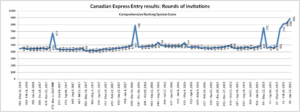
Canada to admit nearly 1 million immigrants over next 3 years (2018, 2019 & 2020)
Canada will welcome nearly one million immigrants over the next three years, according to the multi-year strategy in what it calls “the most ambitious immigration levels in recent history.”
The number of economic migrants, family reunifications and refugees will climb to 310,000 in 2018, up from 300,000 in 2017. That number will rise to 330,000 in 2019 then 340,000 in 2020.
Five million Canadians are set to retire by 2035 and Canada have fewer people working to support seniors and retirees.
Canada’s Express Entry system is dynamic, meaning a candidate’s Comprehensive Ranking System score isn’t fixed but may be improved if she or he is willing to put in the effort.
There are two key ways that you can try to improve your CRS score:
- Perfect your profile.
- Language
- Education
- Spouse/partner as a primary applicant
- Work experience
2. Proactively prepare for an ITA or provincial nomination
History of CRS Score – Rounds of Invitations since 2015
Perfecting your profile
Representing yourself accurately in your Express Entry profile is extremely important. Not only could it earn you extra Comprehensive Ranking System (CRS) points, but there are also serious penalties for misrepresenting yourself.
The first thing to keep in mind is that the credentials required to enter the Express Entry pool are not necessarily the same as those that will maximize your CRS score.
Language
Language is an example of a valuable factor within the CRS and can be worth up to 290 CRS points.
Language is also an area that can often be improved because the levels required to enter the Express Entry pool are significantly lower than the level that awards the maximum CRS points.
For a Federal Skilled Worker candidate to enter the Express Entry pool, a minimum Canadian Language Benchmark (CLB) of 7 is required in each language ability — reading, writing, speaking and listening.
However, the highest language level for which points are awarded within the CRS is CLB 10.
Language is also valuable because it counts for points in several sections of the CRS:
- Within the human capital factors;
- Within the skill-transferability “combinations”;
- Within the additional factors.
A CLB of 9 or higher is needed in all four language abilities — reading, speaking, writing and listening — in order to obtain the maximum of 50 points.
Having even one ability below CLB 9 could prevent you from getting the full 50 points. Conversely, improving a single ability could earn you many points.
Education
Education can count for up to 230 CRS points and may be improved by obtaining additional credentials, for example completing another degree, or by obtaining additional Educational Credential Assessments (ECAs) for existing degrees.
An ECA is required in order to obtain CRS points for education obtained outside of Canada.
For the Federal Skilled Worker Class candidates educated outside of Canada, only one ECA is required of the principal applicant in order to enter the pool.
For candidates in the Federal Skilled Trades Class or the Canadian Experience Class, no ECA is required to enter the Express Entry pool.
Spouse might be a better Principal Applicant
If you have a spouse, it may be beneficial to compare your CRS scores as principal applicants.
Sometimes a main applicant’s CRS score may, in fact, be lower than that of their accompanying partner. In such cases, it may be advisable for a spouse to be the principal applicant.
Work Experience
Obtaining additional work experience or better documenting current work experience may both help increase a candidate’s CRS score.
Some candidates who have a job title that seems unskilled may, in fact, have performed duties that are considered skilled under Canada’s National Occupation Classification, or NOC.
Going beyond job title, and measuring the duties you performed against the duties listed in the NOC’s different occupations can help determine if your work is considered skilled or unskilled. This, in turn, can result in points you might have otherwise not claimed.
After selecting the right NOC for your work experience, the next step is calculating how much time you spent at each job. Points are awarded for full-time or equivalent part-time work experience.
Federal Skilled Worker Class candidates must have at least one year of continuous, skilled work experience in order to enter the pool. However, even non-continuous work experience can count toward CRS points.
Work Experience and Provincial Nominee Programs
Documenting your work experience as precisely as possible can also make you eligible for a nomination by one of Canada’s Provincial Nominee Program, better known as PNPs. Express Entry candidates nominated by a Canadian province for permanent residence are awarded an additional 600 points toward their CRS score.
Provinces sometimes look for candidates with specific work experience that you may, in fact, have, but do not consider to be relevant because it is not related to your principal occupation.
Proactive Preparation
Regardless of your CRS score, everyone in the Express Entry pool should be proactively preparing for an ITA or provincial nomination.
You might only have a CRS score of 299, but a provincial nomination could suddenly increase your score by 600 points, making an ITA in the next Express Entry invitation round all but guaranteed.
Candidates have only 90 days to submit their complete application after receiving an ITA, and several PNPs afford even less time. Having documents prepared in advance means you can hit the ground running as soon as you’re invited.
Express Entry Provincial Nominee Programs (PNPs)
Among these are several programs that:
- Do not consider a candidate’s CRS score among their eligibility requirements; and
- Are open to candidates with no ties to Canada (such as a relative, job offer, or previous Canadian work or study).
These PNPs can be valuable to Express Entry candidates and are therefore extremely popular.
Many operate on a first-come, first-served basis and reach their intake quotas within a day of opening, and proactive preparation is sometimes the only hope for applying successfully.
Two examples of first-come, first-served PNPs that are only open to Express Entry candidates are Saskatchewan’s International Skilled Worker — Express Entry sub-category and the Nova Scotia Demand: Express Entry Stream.
| Saskatchewan’s International Skilled Worker: Express Entry sub-category | Nova Scotia’s Demand: Express Entry | |
| Does it function based on a first-come, first-served basis? | YES | YES |
| Does it consider your CRS score? | NO | NO |
| Is it open to specific occupations? | YES | NO |
| What is the selection system? | Unique eligibility and points-system | Unique eligibility and points-system |
| Do they provide advance notice of before the next intake? | NONE | 1 DAY |
| How many times has the program opened since January 2017? | 6 | 3 |
| How long does it take for the intake threshold to reach its capacity? | LESS THAN A DAY | LESS THAN A DAY |
Neither stream considers a candidate’s CRS score, and each has a unique points-system and a list of eligible occupations.
Both have opened intermittently in the recent past — the Saskatchewan program typically opens with no notice and Nova Scotia provides little notice.
Given this small application window, many applicants prepare well in advance in anticipation of these streams re-opening.
There is an element of risk to preparing in advance, namely that PNP requirements and eligibility criteria can change without notice.
But even if that’s the case, the silver lining is that many of the documents required by PNPs are also needed to pursue an Express Entry ITA.
Ontario Human Capital Priorities Stream
Another PNP that may reward proactive candidates is Ontario’s popular Express Entry-linked Human Capital Priorities Stream.
This active stream is not first-come, first-served, but instead follows a so-called passive model that allows Ontario to search the Express Entry pool and select candidates with a CRS score above 400 and the skills that match the province’s labour needs. It is worth noting, however, that Ontario once waived the 400 CRS point requirement for IT professionals.
Express Entry candidates who receive an invitation through the Human Capital Priorities Stream must submit their application within 45 days, which can be a tight timeline in which to collect all the required documents.
Besides collecting documents, Ontario has advised Express Entry candidates interested in the Human Capital Priorities Stream to create a new profile in the Express Entry system. This is to make it easier to identify their profile when Ontario searches the Express Entry pool.
As is the case with the Nova Scotia and Saskatchewan Express Entry streams mentioned above, candidates who are interested in the Ontario Human Capital Priorities Stream should keep a close eye on new developments with the stream, and take steps to be proactive if or when an opportunity presents itself.
Other Express Entry-linked PNPs
The provinces of Manitoba and Prince Edward Island both introduced streams where eligible Express Entry candidates can also proactively submit profiles to the provinces, which then rank candidates within their own pools and ranking systems.
The Province of New Brunswick has also opened its Express Entry Labour Market Stream for limited periods, both to IT professionals and others.
One factor all of these different PNPs have in common is that they reward proactive, informed candidates.
PNPs will continue to play a prominent role in terms of economic immigration to Canada through 2020, with 11 per cent increases in admission targets forecasted in both 2019 and 2020.
So keep in touch with us, and get busy preparing those documents!
Like and follow us on Facebook https://www.facebook.com/nexeraimmigration/
Email us your resumes at info@nexeraimmigration.com for free assessment.
Include your Date of Birth, Marital Status and spouse’s date of birth and their education and experience.


Recent Comments